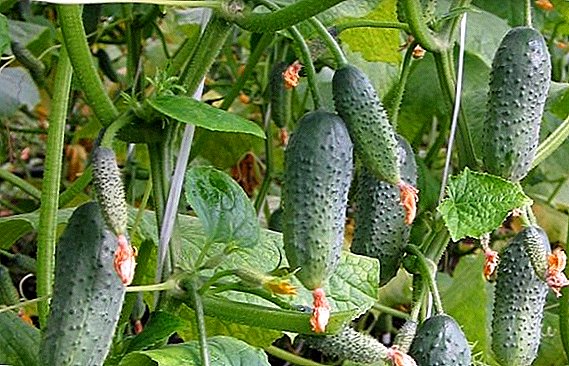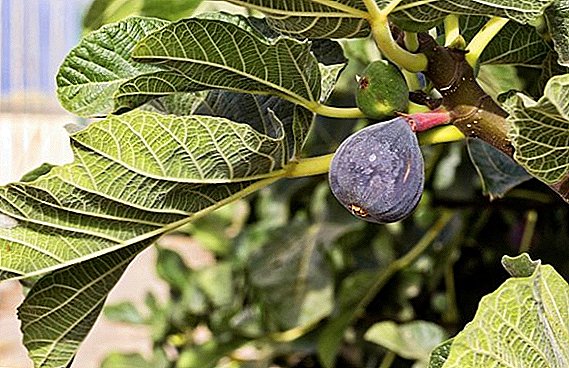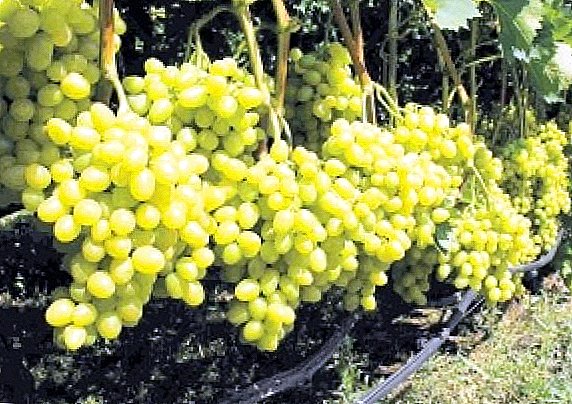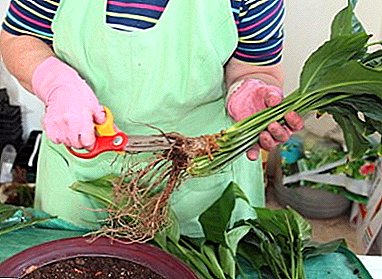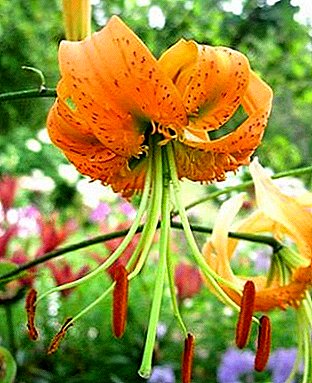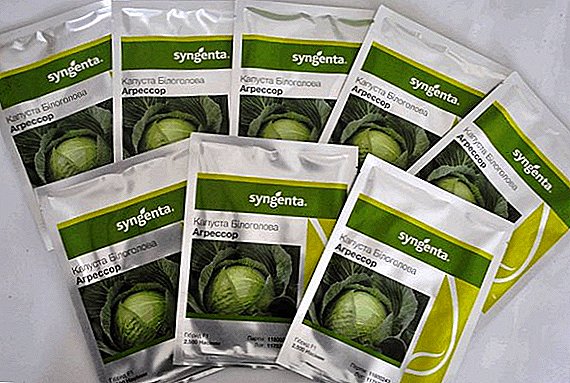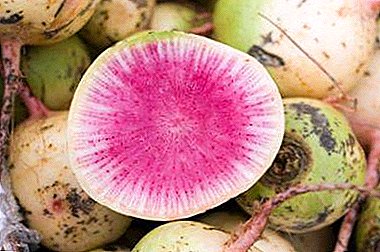
Watermelon radish (sometimes called radishes) is a hybrid that is already very popular in America. But here in Russia gardeners only began to look narrowly at him.
Therefore, the experience of growing this vegetable from domestic agronomists is not very much. In this article we will tell in detail what kind of root crop is and how to properly care for it in order to get a rich harvest. And also we will learn the advantages and disadvantages of the variety, its composition and properties, and what are the differences from other types. Find out where and for what watermelon radish is used and how to deal with pests.
Detailed description and description
Appearance and photo
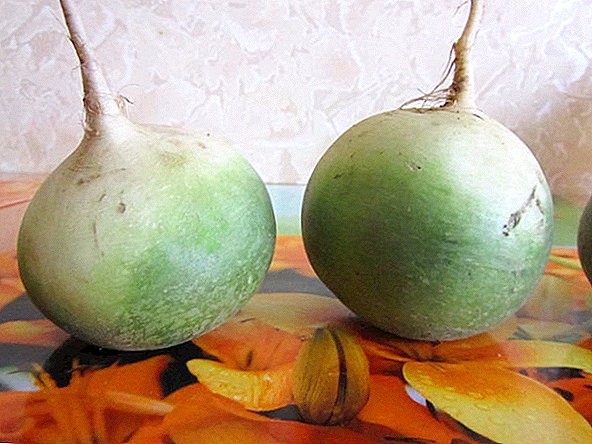
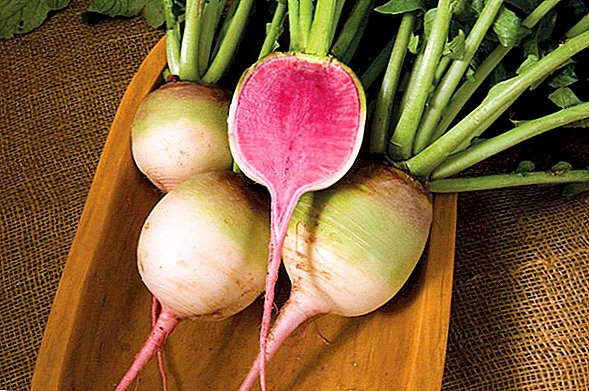
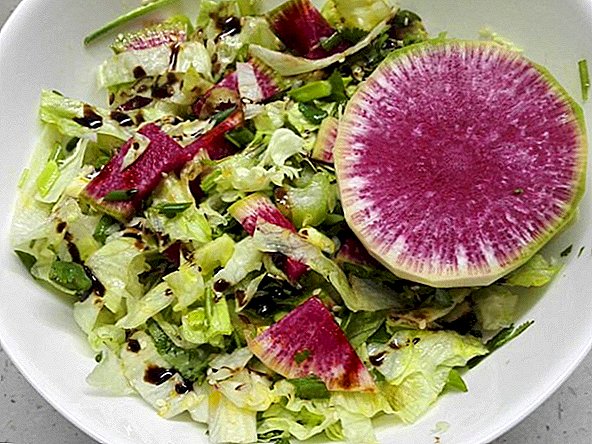
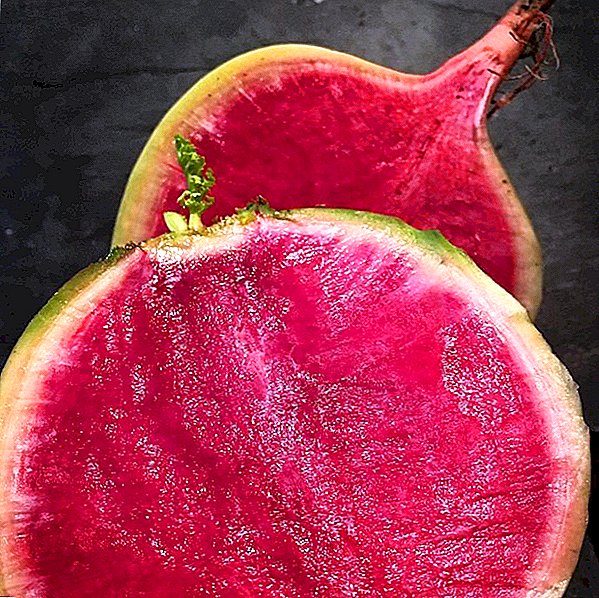
Radish fruits resemble watermelon, but not taste, and its appearance. Inside the watermelon hybrid is the same pink, and sometimes saturated purple. The shape of the fruit is round, in diameter usually reach 8 centimeters. The skin of a radish has a delicate shade - somewhere between white and light green.
Reference! A distinctive taste of this fruit is that it is less juicy and even a little hard. The more ripe the fruit, the more pronounced its taste.
However, even a fully ripe vegetable will have a bitter taste closer to the middle of the fruit. But The edges of the radish are pretty sweet.
Sowing time
The fruit ripens within a month. This property allows agronomists to grow several harvests in one season. Watermelon radish is planted as seeds immediately in open ground. This should be done only when the soil is warm enough. In different regions, this period occurs at different times. However, this will not happen before the end of April – mid-May.
Productivity from 1 hectare
Watermelon radish has a high yield. Gardeners say that with proper care, you can get several tens of tons per hectare.
Where is it recommended to grow?
This root crop can be planted both in the greenhouse and in the open ground. You can even sow it at home. Indicators of seedlings and growth in radish are beautiful. However, it is worth remembering that this vegetable loves a short light day. If there is enough light, the fruits will become bitter and hard. Therefore, the place for cultivation needs to choose a more shaded.
Disease resistance
Breeders conscientiously worked on the breeding of this hybrid. therefore Watermelon radish turned out quite resistant to various diseases and pests. However, this does not mean that you can forget about preventive measures. Periodically to feed a vegetable to increase its immunity is still necessary.
Ripening
We have already said that watermelon radish mainly grows in 30 days. At the expiration of this period, the fruit can already be dug out and eaten. It will not be possible to store radishes for a long time - a maximum of 2 months and then at temperatures not higher than 6 degrees Celsius.
What kind of soil does it prefer?
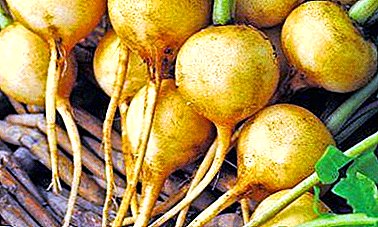 The most suitable ground are sandstones and clayey lands. Acidity should not exceed average (about 7).
The most suitable ground are sandstones and clayey lands. Acidity should not exceed average (about 7).
With increased acidity of the soil, it is better to carry out a liming procedure before planting. It is important to ensure that the soil is well friable and saturated.
However, the earth should not be too full of organic matter.
In autumn, the earth must be dug up without fail, as well as fertilize with manure or chicken droppings.
Important! The optimal amount of manure is 4-5 kilograms per 1 square meter. You also need to feed the soil with potash and phosphate fertilizers in the autumn.
Before winter, the land is mulched. Well planted radish in the area where previously grew cucumbers, potatoes or legumes. It is better not to plant a root vegetable after carrots, cabbage and beets.
Breeding history
For the first time watermelon radish bred in Europe. However, on this continent, it has not become popular. Then agronomists began to popularize this vegetable in the US states, they succeeded - the Americans appreciated this product. But in Russia, watermelon radish appeared relatively recently - at the beginning of the two thousandth.
What is the difference from other species?
The first difference is taste. Watermelon radish less juicy. It should be said about the combination of two tastes in this product - sweet and bitter. Also a feature of radish can be called the fact that the more time it overrides, the less taste it remains. I.e, if the agronomist does not harvest at the right time, he will get a tasteless product.
The advantages and disadvantages of the variety
The advantages include:
- high yield;
- fast ripening;
- resistance to diseases and pests.
But the disadvantages include
- short shelf life;
- as well as the fact that, with long-term cultivation, the taste qualities of watermelon radish decrease, and eventually disappear altogether.
What and where is it used for?
Not only fruits, but also radish foliage are usable. Both the first and second are added to salads, okroshka and other cold soups.
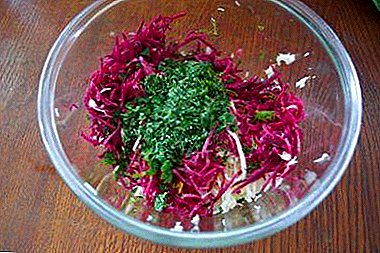 This vegetable can be baked, served as a mashed potatoes as a side dish. Cooks say that mashed potatoes are perfectly combined with cream.
This vegetable can be baked, served as a mashed potatoes as a side dish. Cooks say that mashed potatoes are perfectly combined with cream.- The stewed product is served with meat, poultry and fish. Add it to the vegetable stew. However, the peel is cleared.
- Now it has become fashionable to cook radishes from cocktails, replacing it with lemon or other citrus fruits.
- Due to its external data, watermelon radish is used as decoration of dishes.
Chemical composition
With regard to energy and nutritional properties, watermelon is not inferior to ordinary radish.
It contains such micro and macro elements:
- sodium;
- calcium;
- magnesium;
- fluorine;
- phosphorus;
- iron;
- B vitamins;
- vitamins A, C;
- nicotinic and salicylic acids;
- potassium.
Appreciate the vegetable and for the high content of dietary fiber.
Reference! The unique composition of radish is considered to be due to the high content of carotene, enzymes, as well as essential amino acids. 100 grams of the product contains only 20 calories.
Useful and harmful properties
We have already written about how many vitamins, micro-and macro elements are in watermelon radish.
- Such a rich composition improves the functioning of the whole body and boosts immunity.
- Also, experts recommend to use it to people suffering from a problem with the cardiovascular system.
- Well influenced root vegetables on the digestive system.
- Radish calories - only 20 calories per 100 grams. Therefore, this product is included in the diet of those who wish to lose weight.
Contraindications include gastric ulcer and increased acidity. Because Radish greatly irritates the mucous membrane.
Growing varieties: planting and care
Remember that the soil should already be warmed up before planting.
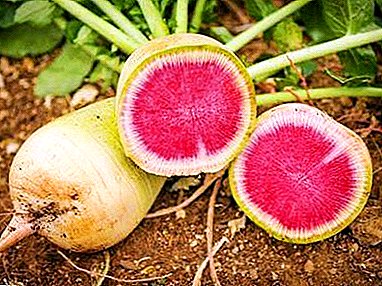 For each seed a well is prepared with a depth of about 4 centimeters.
For each seed a well is prepared with a depth of about 4 centimeters.- Mineral fertilizer in granules is put on the bottom of it, all this is sprinkled with soil, and only on top of this are seeds placed and also covered with a small amount of earth.
- Then all crops need to be watered with water at room temperature.
Shoots will appear in a few days.
Watermelon radish develops poorly in cramped. Therefore, when planting, it is important to consider this fact.
One of the main rules of care is timely moistening. Watering is necessary regularly, but not very plentiful. If moisturizing occurs incorrectly, voids are formed in the fruit. It is also necessary to observe the amount of light. If there is a lot of it, then the radish will begin to produce unnecessary arrows.
In order for the vegetable to receive the required amount of light, need to sow the seeds near trees or shrubs. If this is not possible, after the first shoots appear, cover them with a black punctured film or a fine mesh. The most suitable growing temperature ranges from 20-25 degrees Celsius.
Twice a month mineral fertilizers rich in potassium and phosphorus are applied to the soil.
Harvesting and storage
You can not be late with the harvest, as the watermelon radish loses its taste. A month after planting, you can collect ripe fruit.
It is best to store them in the basement at a temperature not higher than 6 degrees Celsius, but not lower than zero. The room should be dry, well ventilated. It is best to put lime into the walls before putting the radish in it.
Diseases and pests
High levels of acidity can cause the development of viral keels. In this case, the fruits become unattractive externally, as well as completely unsuitable for human consumption. If you pour a lot of radish, fungal diseases can develop. To prevent this from happening, it is necessary to observe the soil moisture regime, as well as loosen it as often as possible.
But the main hazards for radishes are cruciferous flea and cabbage fly. These pests eat leafy plates, which leads to the drying of fruits.
Prevention of various problems
Also Good scare away harmful insects smell of garlic. It can be added to the water a few hours before watering, so that the garlic can sing. Moreover, they apply not only the teeth themselves, but also the husks.
Of the finished products fungicides help well. They are bred, strictly adhering to the instructions. It is worth applying solutions several times with a break in 5-7 days.
Watermelon radish is a unique product whose popularity in Russia is only gaining momentum. However, those who grew a vegetable or prepared dishes from it, already appreciated its taste, as well as a positive effect on the overall condition of the body.


 This vegetable can be baked, served as a mashed potatoes as a side dish. Cooks say that mashed potatoes are perfectly combined with cream.
This vegetable can be baked, served as a mashed potatoes as a side dish. Cooks say that mashed potatoes are perfectly combined with cream. For each seed a well is prepared with a depth of about 4 centimeters.
For each seed a well is prepared with a depth of about 4 centimeters.
